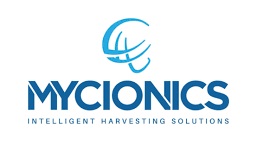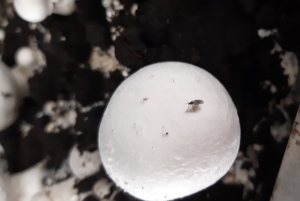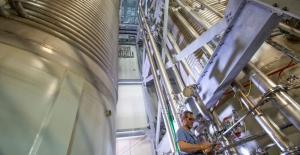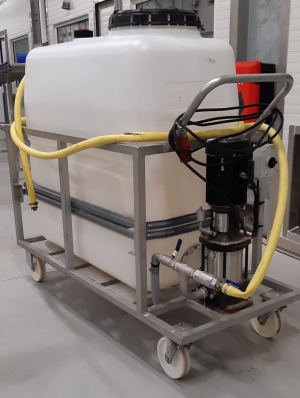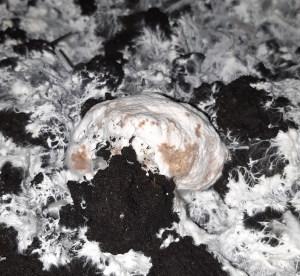Recognise, isolate and control
These three principles are the base of disease control on a mushroom farm. To my opinion there is no farm that has not a spot of disease somewhere.
But depending on what is done it will develop into a serious problem or it will stay a hidden time bomb.
If a problem is discovered it is of crucial importance that is recognised. To make sure that will happen training of people on the farm and especially pickers is needed. They are your eyes on the farm.
They need to know the most common diseases and especially in a young stage. Many places of dry bubble are not recognised and are only seen if the disease is in an almost incurable stadium. The small wart on a mushroom or grey spot is often missed.
The same goes for insects. Many growers do not know the difference between a phorid and a sciarid. Although the damage pattern is totally different, so Is the threshold where it really starts costing production. Also the cure is completely different.
Example: growers use diflubenzuron against phorids.
It is only active against sciarids.
If the disease is recognised then it should be isolated. It can be covered on the spot but the most important is to simply keep all doors closed. Check filters and door seals. If a room is infected, make sure the infection is contained in that one room and does not spread on the farm.
After the isolation the disease can be treated. If the spot is detected in an early stage one can do with just a sport treatment. If it is more the whole room should be taken on.
But too often the infection spreads and the whole farm must be treated. Generally room treatment for a full cycle with an overlap of two or three rooms to break the lifecycle of the disease.
So, just a test:
Look at the photo and spot the phorid. Or is it a sciarid?
Organic trend stimulates the sales market
The consumer demand for residue-free food is increasing, and chemical alternatives in mushroom cultivation are becoming less and less available.
E-nema GmbH supports this change. It is the world market leader and has decades of experience in the production of useful nematodes.
Useful nematodes are natural opponents of many pests in ornamental plant breeding, on strawberry, blueberry and apple orchards as well as in maize cultivation. They are also increasingly being used, successfully within the mushroom cultures, in the fight against sciarids.
Nematodes are barely visible to the naked eye, but they are very effective. They are sent all over the world to be used in biological crop protection.
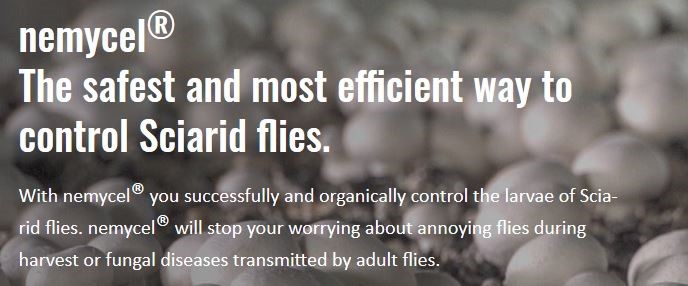
The main sales markets are currently in Europe and North America, but countries such as New Zealand and Africa are also increasingly relying on biological alternatives to chemical crop protection.
E-nema maintains close contact with its customers and will in future, be at the side of the mushroom grower as a partner with scientific expertise and an effective biological product against sciarids.
Despite the pandemic, sales of the north German company e-nema GmbH rose by more than 30% last year.
The company will continue to invest in modern systems and in the qualifications and motivation of its employees. Their number is expected to increase from currently 60 to 100 in the coming years and a doubling of sales from 10 million in 2019 to 20 million by 2024 is also planned.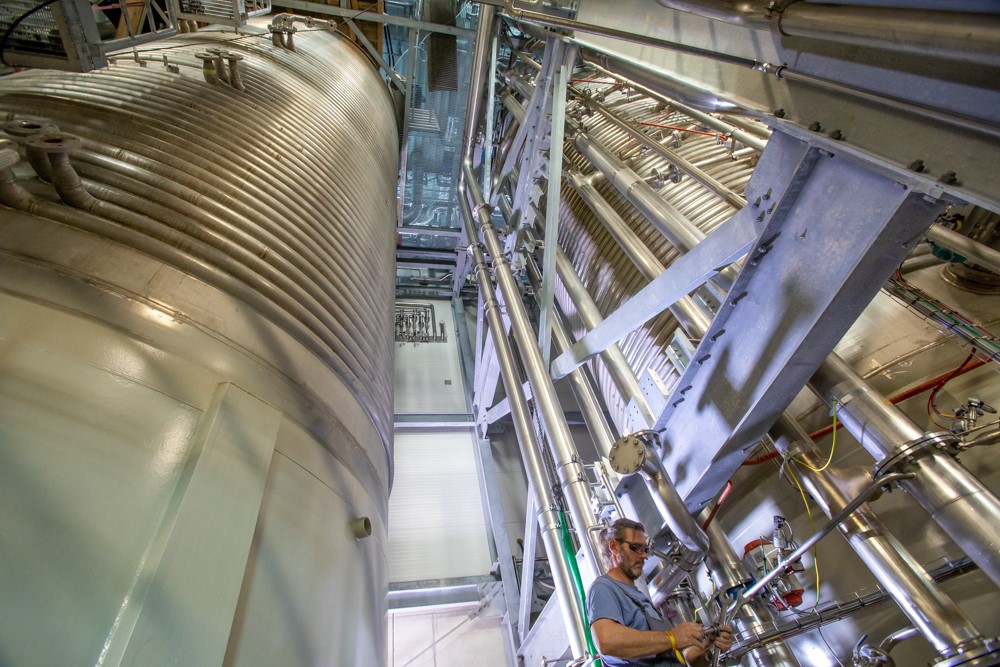 In these huge bioreactors, e-nema GmbH produces useful nematodes for biological crop protection
In these huge bioreactors, e-nema GmbH produces useful nematodes for biological crop protection
Photo: k-film, Michael Kottmeier
And they keep flying…
I am writing this blog on November 2. 2020.
It is the warmest November day ever. The outside temperature today will hit 20° C. Normally this time of the year in Europe growing is fairly easy. Older growers always say: just open the doors and let the outside climate do the job. This year and probably oncoming years the situation is different. It starts with arable crops being harvested later than normal. The potatoes are still being harvested and the corn is only gone this week. Meaning that there was a lot of dust and organic material flying around. Especially since many farms are situated in rural areas. All this organic matter being airborne has caused a big problem with Mycogone and verticillium. But another and maybe even bigger problem is that the insects are still there. It is known that phorids stop flying around 5° C and sciarids even fly till it starts freezing. And that situation seems to be far away. And that is why I see at many farms that the infection with sciarids was almost gone but is returning (rapidly) again. Because their hiding place in the corn is gone. Just at the moment when many farms are scaling down on fly control. The combination of these two factors, the insects and the dust causing bubble, is a dangerous one which may last for another month or so. What to do about it? Trying to kill the verticillium or Mycogone is the first thing growers do but if the vector (insects) to carry the spores is still there the problem stays. That is why I always try to aim at the insects first. In this case practically always a problem with mosquitos or sciaridae. Often chemicals are chosen and many times a combination of a short term chemical by fogging and a long term chemical as a drench on the casing soil. But lately I see very good results (as good as the chemical treatment) with the biological control with nematodes as a drench on the casing. In price there is not much difference but in application it does make a difference. It is not dangerous for the person who applies it and it is not dangerous for the environment. On the other hand it is noticed that many supermarkets want a clean, read: chemical free, product. And nematodes are not regarded to be dangerous. Even more, farms use it as advertising for their product. It is the same as with my own business “Akkie’s Tuin”. An apiary and orchard. We do not use chemicals, only biological control and we use that as a selling point. We notice that we can get higher prices for our products by working organic. The only thing is that the customer needs to know what you do. With the product goes the story about what you do. So if you have an insect problem at the moment take this into consideration. A few remarks on the use of nematodes. Make sure they are delivered fresh onto the farm and put them into the cold store right away. Overheated nematodes will die. When using them, you need sciarids on the farm. The nematodes feed on the larvae of the mosquito and if there is no food they will die. The manual about using the nematodes often says that they have to be applied directly after casing the compost. I however have better experience in the so called split application. So not the 2 million nematodes per m² directly after casing but 1 million on the casing day and the other 1 million 4 to 7 days later. I prefer 2 days before the start of the recovery period as the last day of application. So practically this means the second application on day 4 after casing. If you apply it a day before recovery you knock back the mycelium too much.
But whatever you do, do it now. If you think that frost will stay away for a while and you see some sciarids flying around, waiting is not an option. Especially is you also have a bubble problem. And the difference between sciarids and phorids is fairly big. As a reminder: Phorids have a nasty smell if you smash them under your finger, a sciarid has no smell. Phorids are fast moving. They walk fast. A sciarid has the tendency to just sit. Phorids are a lot smaller and the antennae are practically not visible while the sciarid has large visible antennae.
Mycogone: easy come, easy?
Mycogone or wet bubble is making its appearance again on many farms. Growers are looking for all different chemical solutions and are gearing up hygiene measures. Most of the times too late. Because chemicals also do a lot of damage to the crop and the schedule often is simply too short to give the right effect.
And as for gearing up hygienic measures, one real big grower once said to me:
If I have no disease I am really worried because nobody is paying attention anymore to hygiene. If on the other hand I dó have a disease everyone is doing what the can.
For Mycogone it is important to look at the origin and take that away. It is a fungus growing in soil, sand or rotting materials. That is why many growers point at the casing soil. Not really correct because it does not grow in deep dug peat because the ph is too low. But casing soil polluted with sand will be infected so it is better to look at transport, the act of casing the room and the circumstances around that.
The spores of Mycogone are not airborne by themselves. The need a vector of taxi. In most of the cases this is dust, animals, people or insects. Especially dust is a factor that is hard to control.
The moving of soil in the vicinity of the room that you are filling is a guarantee for infection. So is the harvesting of agricultural crops near the farm if the wind is blowing the dust to your farm.
So keeping the room that you are filling and the casing soil out of the wind to avoid dust is already a good thing. So is cleaning of the trucks before they enter the filling area. And flushing with plenty of water may be more effective than using a disinfectant.
At the same time keep the whole area wet so dust cannot fly around.
For growers who use casing soil in plastic bags, do not bring them into the room or wash them before use. Plastic is electro static and attracts dust.
It is a myth by the way that Mycogone comes in with the compost. It cannot grow in phase 3 compost.
The following point is people. If the filling team walks through grass or sand during filling, again that is a major failure. So is not wearing clean clothes at the moment of filing. Also do not let the filing team have their coffee break in the same canteen used by the pickers. When they return to the job they may be covered in spores.
A thing harder to control is insects. If you have an infection of sciarids or phorids on the farm an outbreak of bubble is likely to happen. But one of the next blogs will be about these creatures.
One general remark: keep the farm and the vicinity clean at all times. Free from rests of casing and compost but also free from paper, cardboard and other mess. This will help to fight all types of disease.






